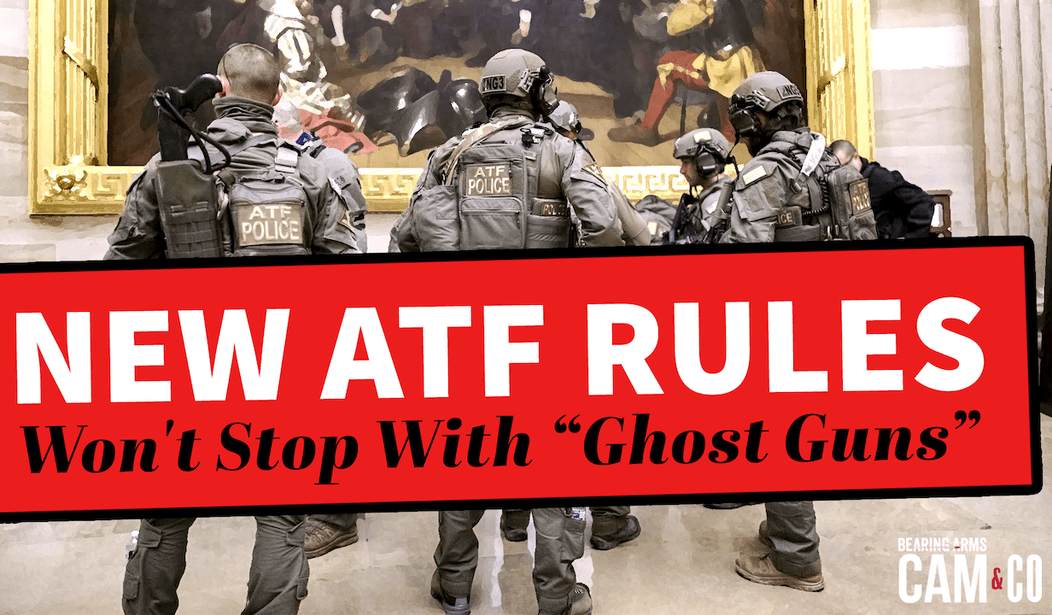The ATF’s new rules on unfinished frames and receivers are now in effect, and more regulations imposing new restrictions on pistol stabilizing braces are on the way, but the gun control lobby is already laying the groundwork for the Biden administration to go even bigger by targeting modern sporting rifles and perhaps even all semi-automatic firearms through regulation in the coming months.
The lawsuits challenging the legality of the ATF’s rules aimed at cracking down on unserialized firearms will continue even though two federal judges declined to issue injunctions preventing the rules from being enforced, but the Biden administration and the gun control lobby are undoubtably going to be emboldened by Tuesday’s decisions, especially when you have a Trump-appointed judge saying things like this:
On Tuesday, Peter D. Welte, chief judge on the U.S. District Court for the District of North Dakota, denied their requests for a preliminary or permanent injunction, writing that the Biden administration had acted within its authority in laying out the rule. Welte, nominated in 2019 by President Donald Trump, wrote that the new measure “was and remains constitutional under the Second Amendment.”
“Without a doubt, this case presents divisive issues that all parties care about deeply and that are of national concern and importance, as demonstrated by the participation of nearly every state in this country in this action,” he wrote in a 27-page order. “Nevertheless, the court’s role and responsibility remains the same — to apply the law to the facts (and not the arguments or policy) of each case.”
The new rules don’t prevent individuals from building their own guns at home, but do require makers of DIY kits to serialize the unfinished frame or receiver that’s included, which also means that sales of these kits will have to go through a federally licensed firearms dealer and purchasers will have to undergo a background check beforehand. There’s been some confusion about whether the new rules apply to 80% frames and receivers that aren’t sold as part of a kit, with Justice Department attorneys claiming at a hearing in Texas last week that companies like Division 80, which challenged the new rule, would not be impacted by its provisions.
Pressing for a preliminary injunction, Division 80’s attorney, Cory Liu of the Ashcroft Law Firm in Austin, said in a hearing Tuesday that the company’s owner, Brandon Padilla, has no other job and his livelihood depends on its current business model.
“Why doesn’t he just get the [federal firearm] license?” U.S. District Judge Jeffrey Brown asked.
“There’s a thriving market of people who want to make their own guns and don’t want to go through licensed dealers,” Liu explained. “Padilla’s entire product line would be wiped out; consumer demand wouldn’t be there.”
“It’s not just about a license,” the attorney added. “It’s about the ability to build a firearm, a right that’s existed since the nation’s founding.”
But Liu’s arguments were undercut by a disclaimer from Justice Department attorney Daniel Riess, after Liu showed Brown a receiver Division 80 sells for an AR-15 style rifle, the most popular firearm in America.
Riess gave the judge a paper with illustrations taken from the ATF’s final rule, outlining what it does and does not consider to be a receiver.
To qualify as a regulated receiver, Riess explained, the part must come with a “jig” or template – typically a piece of plastic that snaps into place to guide the purchaser on where and how deep to drill holes – drill bits and instructions, making the receiver “readily convertible” within minutes to a fully functional firearm.
Liu was flabbergasted. “That’s news to me,” he said. “For months, we’ve been asking what role do instructions and tools play in this. You can sell a receiver blank without tools and jigs. That’s news to me. Had this handout been posted on ATF’s website that would have cleared up a lot of questions.”
Brown asked if that doomed Division 80’s injunction request: “What if the product can still be sold? Is that fatal to a preliminary injunction? Or are you still saying you want an injunction?”
But Liu said the revelation just proves Division 80’s contention the rule is unconstitutionally vague. He said it is so open-ended the public can’t understand it.
“They want the rule to be as ambiguous as possible. And they’ll just give handouts on a case-by-case basis to meet their need,” he griped.
That certainly seems to be the stance that the industry has taken. I’ve been unable to find any 80% frames or receivers available for sale online today, even those that don’t come with a jig or template. Granted, I haven’t done an exhaustive search, but all of the websites I visited that normally have these products on hand have either officially suspended sales or claim to be “out of stock” at the moment.
So what happens next? Well, the administration’s proposed rule on pistol stabilizing braces is expected to be published in its final form by the end of the year, and if that rule is allowed to go into effect as well then the next big step for the administration could very well be an attempt to regulate modern sporting rifles (or perhaps all semi-automatic firearms) under the National Firearms Act; an effort that the gun control lobby is already pushing in court cases and online outlets like The Trace. If they’re making these arguments publicly, you can be sure that they’re pitching the Biden administration on the idea behind the scenes as well. What’s more, if Republicans succeed in taking control of at least one chamber of Congress this November, then the only way that new gun control measures are going to be implemented for the next two years is through executive action, which will only add to the pressure on Biden to go big with an executive action targeting so-called assault weapons… at the very least.









Join the conversation as a VIP Member